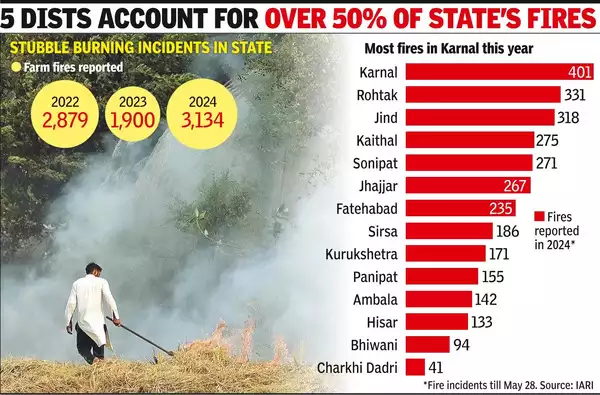Haryana Switch to Hindi
Farm Fires Rise Across Haryana
Why in News?
Farm fires that are used to clear land after wheat harvesting in the summer months reached 3,134 cases in Haryana in April and May, making it the highest number recorded in the state during this period in the last three years.
Key Points
- As per satellite data analyzed by the Indian Agricultural Research Institute in 2023, there was a 42% reduction in farm fires during April-May, with only 1,900 incidents recorded.
- The decrease in figures for 2023 was attributed to a higher number of pre-monsoon showers in the area.
- The Commission for Air Quality Management (CAQM) recently stated that the increased occurrences of burning crop residue in and around the National Capital Region (NCR) and forest fires in neighboring states may be contributing to the poor air quality in Delhi-NCR, alongside dry weather conditions causing dust to linger over the area.
- Public awareness initiatives have been initiated to inform both farmers and the public about the adverse effects of burning crop residue and the significance of embracing environmentally friendly alternatives.
- According to the Center for Study of Science, Technology and Policy (CSTEP), authorities must not only focus on combating air pollution in winter but also address the issue throughout the year.
- Although the negative impact of farm fires causing poor air quality is usually highlighted during October–November, the burning of Rabi stubble in April and May is equally detrimental.
- Even though stubble burning may not significantly affect Delhi's air quality in the summer due to monsoon winds, it does contribute to a decline in air quality in Punjab and nearby regions.
- This situation worsens when stagnant winds persist for several days, hindering the dispersion of pollutants.
Indian Agricultural Research Institute (IARI)
- Indian agricultural Research Institute (IARI), popularly known as Pusa Institute, began in 1905 at Pusa (Bihar) with the generous grant from an American philanthropist, Mr. Henry Phipps.
- Following a devastating earthquake in 1934, the institute was shifted to Delhi on 29th July 1936. Post independence, the institute has been renamed as Indian Agricultural Research Institute (IARI).
- The green revolution that brought smiles to millions of Indians bloomed from the fields of IARI with the development of famous wheat varieties which contributed to massive production.
- IARI continues to be the leading institution for agricultural research, education and extension in the country.
Commission for Air Quality Management (CAQM)
- It is a statutory mechanism to coordinate and oversee diverse efforts to improve air quality in Delhi, Punjab, Haryana, Rajasthan and UP, with the underlying remedial approach.
- The establishment of CAQM has the potential to address the problem of air pollution but an institution by itself is not a solution.


Haryana Switch to Hindi
Haryana to Demolish Illegal Floors
Why in News?
Recently, the Haryana government’s department of town and country planning (DTCP) has issued directions stating that illegally built fourth floors of houses constructed on residential plots may be demolished and their occupancy certificates cancelled.
Key Points
- In February 2023, the Haryana government suspended approval for new 'stilt plus four floors' building plans for residential plots, including pending applications.
- The government has not yet decided whether to allow such buildings across the state.
- The DTCP officials clarified that occupation certificates of those residential buildings, where a fourth floor was built but necessary formalities had not been completed by February 23, 2023, will remain suspended till further directions from the Haryana government on the policy.


Haryana Switch to Hindi
High Power Demand Amid Heatwave
Why in News?
Gurugram is facing a significant increase in electricity demand due to the current heatwave. Recently, the power demand reached a record high of 482.3 lakh units (LU) as the temperature soared to 47 degrees, marking an 84% rise from 2023.
Key Points
- The high demand for electricity is causing significant stress on the city's power distribution system. People all over the city are experiencing unplanned power outages and frequent changes in voltage, resulting in nights without proper rest.
- According to the officials, they are diligently overseeing the situation and implementing necessary measures to avoid power outages or failures.


Madhya Pradesh Switch to Hindi
Encroachments to be Removed from Madhya Pradesh Rivers
Why in News?
According to the sources, a campaign will begin to remove encroachment from rivers and ponds located in rural and urban areas of the district which includes Saraswati and Kanh rivers of the city.
Key Points
- Under the drive,there should be no encroachment within 30 metres of rivers. Action will be taken to remove encroachment from 20 identified ponds of the city and master plan area. Similarly, encroachments are also being removed from 56 pounds in rural areas.
- The sewerage should not be allowed to enter these ponds. Concrete arrangements should be made for this. A mega campaign of tree plantation will also be conducted in the entire district including the city.
Saraswati river
- It is a river flowing through Indore. It doesn't contain freshwater but instead has become polluted mainly due to the pollution of the Kanh river.
- The river flows into a larger body through Kshipra river.
- The Shipra (Kshipra), a tributary of the Chambal River in Madhya Pradesh, flows across the Malwa Plateau.
- It originates in the Vindhya Range from a hill called Kakri-Tekdi, which is in the north of Dhar and situated near Ujjain.
- Khan and Gambhir are its major tributaries.
Kanh river
- Kanh is a river flowing through Indore. The river started carrying sewage in the early 1990s. Several attempts have been made to clean the river, yet it remains polluted.
- The river, along with the Saraswati River, is a part of the Smart City Indore project, and a riverfront spanning 3.9 kilometres has already been developed along the river.Both the rivers are being rejuvenated under the Smart Cities Mission.
- In 2023 the Union government sanctioned Rs. 511.15 Crore for the cleaning of the Kanh and Saraswati rivers, under the 'Namami Gange Programme’.


Uttarakhand Switch to Hindi
Government Starts Granting Citizenship Under CAA
Why in News?
Recently, the Ministry of Home Affairs announced that the government has begun awarding citizenship under the Citizenship Amendment Act, 2024 in West Bengal, Haryana, and Uttarakhand.
Key Points
- On May 15, the initial batch of citizenship certificates was presented to the candidates in New Delhi by the Union Home Secretary, subsequent to the issuance of the Citizenship (Amendment) Rules, 2024, as approved by the Empowered Committee in Delhi.
- The Citizenship Amendment Rules, 2024, issued by the MHA on March 11 2024, have cleared the path for the implementation of the CAA, which was approved by Parliament in 2019.
- According to the guidelines, migrants belonging to six minority groups from Pakistan, Afghanistan, and Bangladesh can apply for Indian citizenship under the CAA, with retrospective effect.
- Under the amendment of CAA 2019, migrants who arrived in India by December 31, 2014, and had faced "religious persecution or feared religious persecution" in their home country became eligible for citizenship under the new law.
- These migrants will be granted expedited Indian citizenship within six years. The amendment also reduced the residency requirement for naturalization of these migrants from eleven years to five.


Uttar Pradesh Switch to Hindi
Evacuation Slides
Why in News?
Recently after a threat of a bomb was reported on a Varanasi-bound Indigo flight at the Indira Gandhi International Airport in Delhi, all 176 passengers on the flight were efficiently evacuated using 'evacuation slides'.
- A search of the aeroplane found that the threat was a hoax.
Key Points
- An evacuation slide is an inflatable slide which allows passengers to safely exit the flight during an emergency, especially when the flight door is high above the ground.
- There are four types of evacuation slides:
- Inflatable slide: The inflatable slide helps passengers descend to the ground from an aircraft exit door. In case they cannot use the doors, they can try to reach either of the aircraft wings. From there, they can use the slide to reach the ground.
- Inflatable raft: It does the same job as the slide, but it can also be used as a life raft in case the aircraft has to land on water.
- Inflatable exit ramp: The inflatable exit ramp is installed to help passengers move from certain overwing exits (or aircraft emergency exits) to the wings, if that path looks better for reaching the ground.
- Inflatable exit ramp/slide: The inflatable exit ramp/slide is there to assist in descending from an overwing exit or aeroplane wing to the ground. It is a combination ramp and wing-to-ground device.
- These are typically made from carbon fibres and a nylon material coated with urethane for fire resistance. Strong fibres are used to build these slides so that passengers are not able to tear them while descending.
- Slides are generally packed and installed within a cabin door or into an external fuselage compartment.
- They are inflated with the help of high-pressure gas carbon dioxide or nitrogen gas containers and ambient air through suction machines.
- Protocols for deploying evacuation slides:
- According to the European Union Aviation Safety Agency (EUASA), evacuation slides must be automatically deployed when the distance between the ground and the flight exit door is six feet or more.
- The inflation time for the slide should be between six and 10 seconds, depending on its location.
- It must be able to withstand temperatures as low as -40 degrees Celsius and as high as 71 degrees Celsius, as well as sustain rainfall of up to one inch per hour and winds up to 46 km/hr coming from 45-degree angles around the airplane, as per the US Federal Aviation Administration guidelines.






%20MPPCS%202025%20Desktop%20E.jpg)
%20MPPCS%202025%20Mobile%20E%20(1).jpg)










.png)
.png)











 PCS Parikshan
PCS Parikshan




